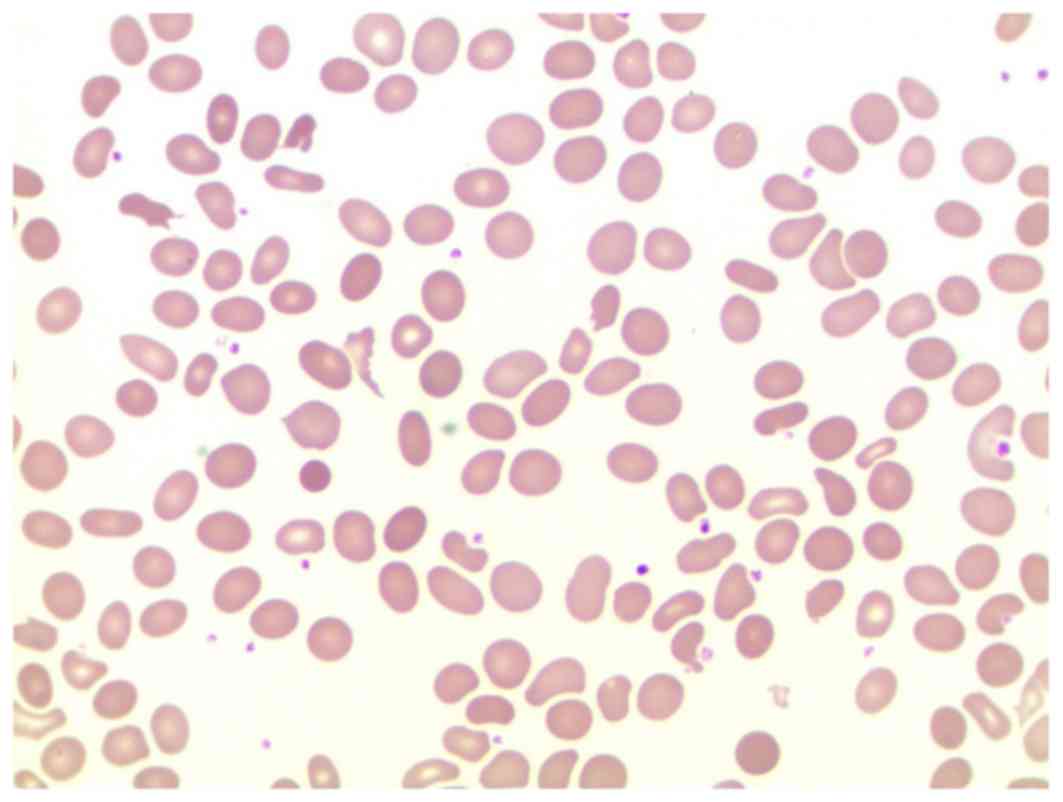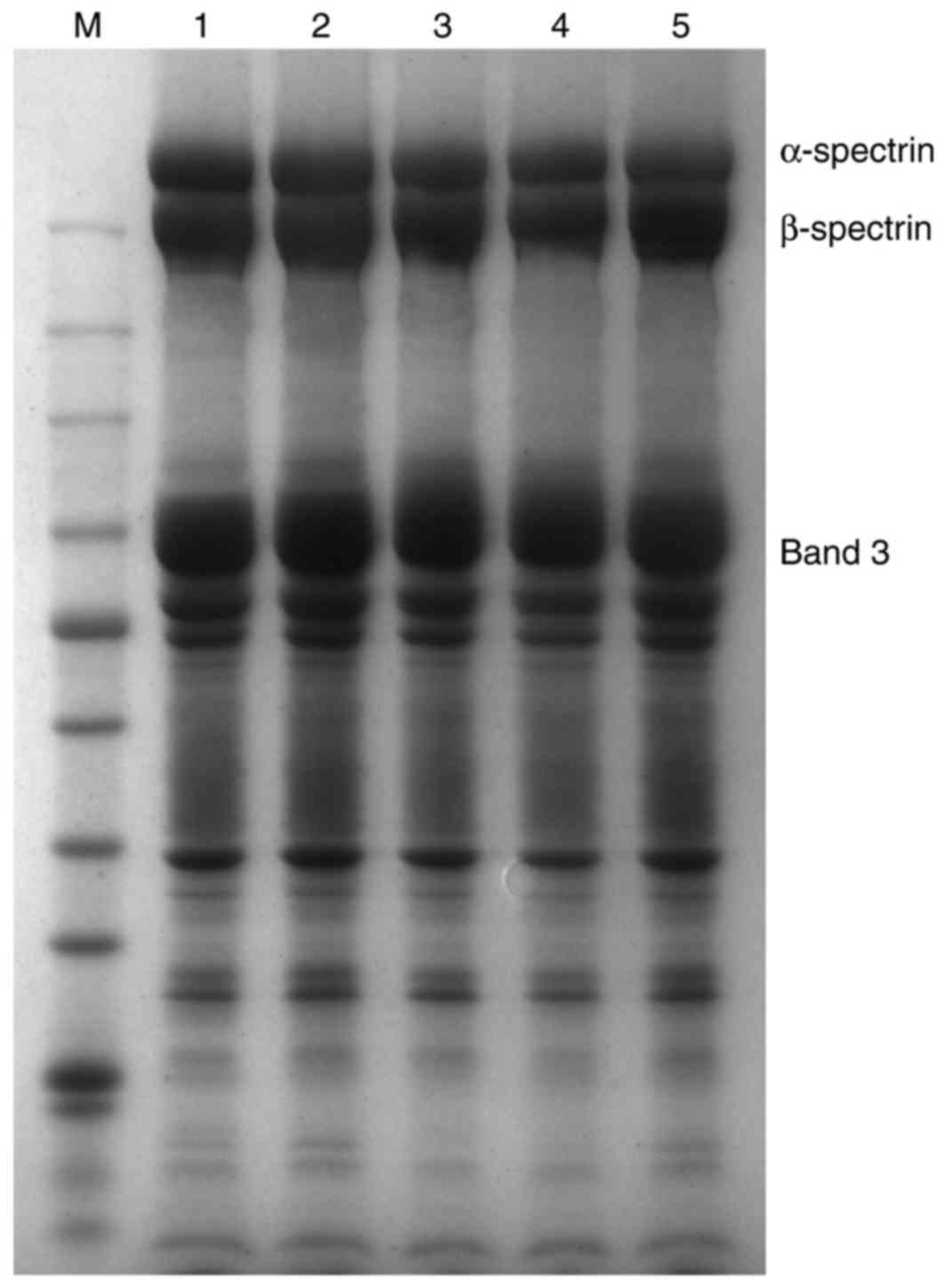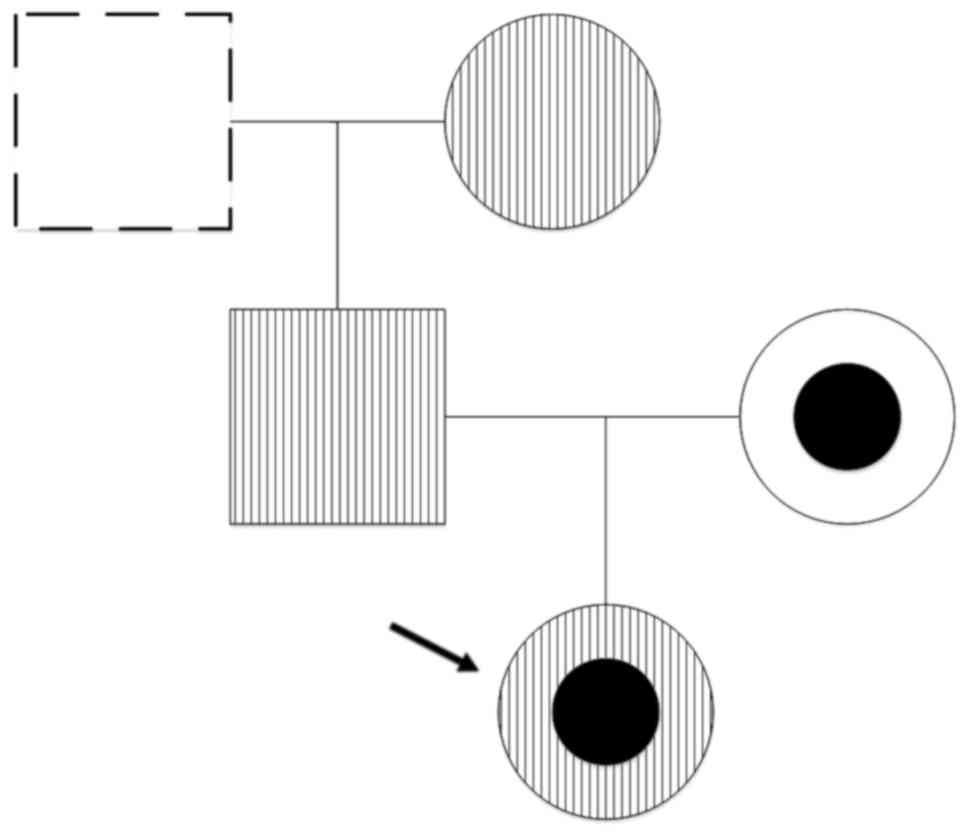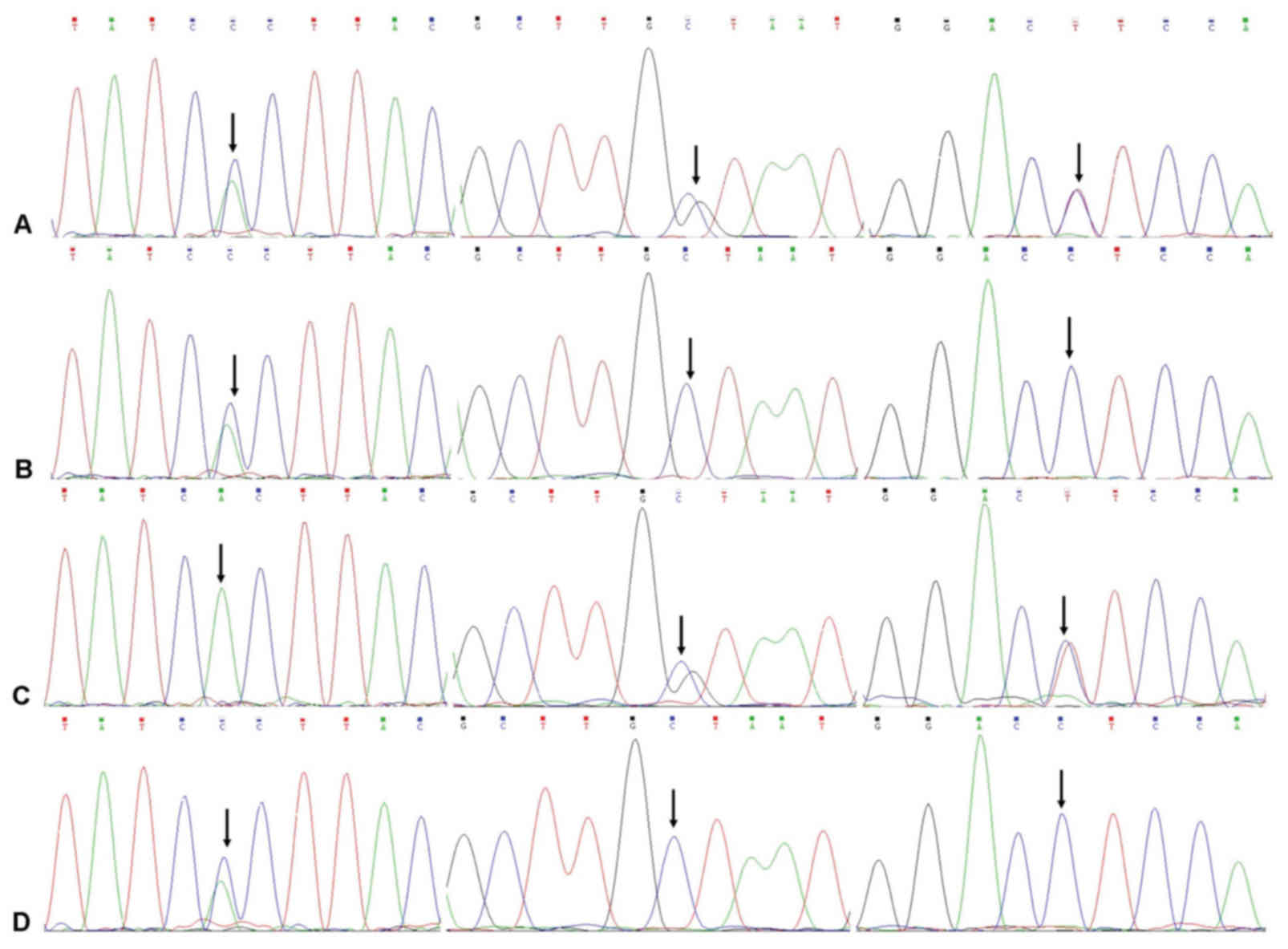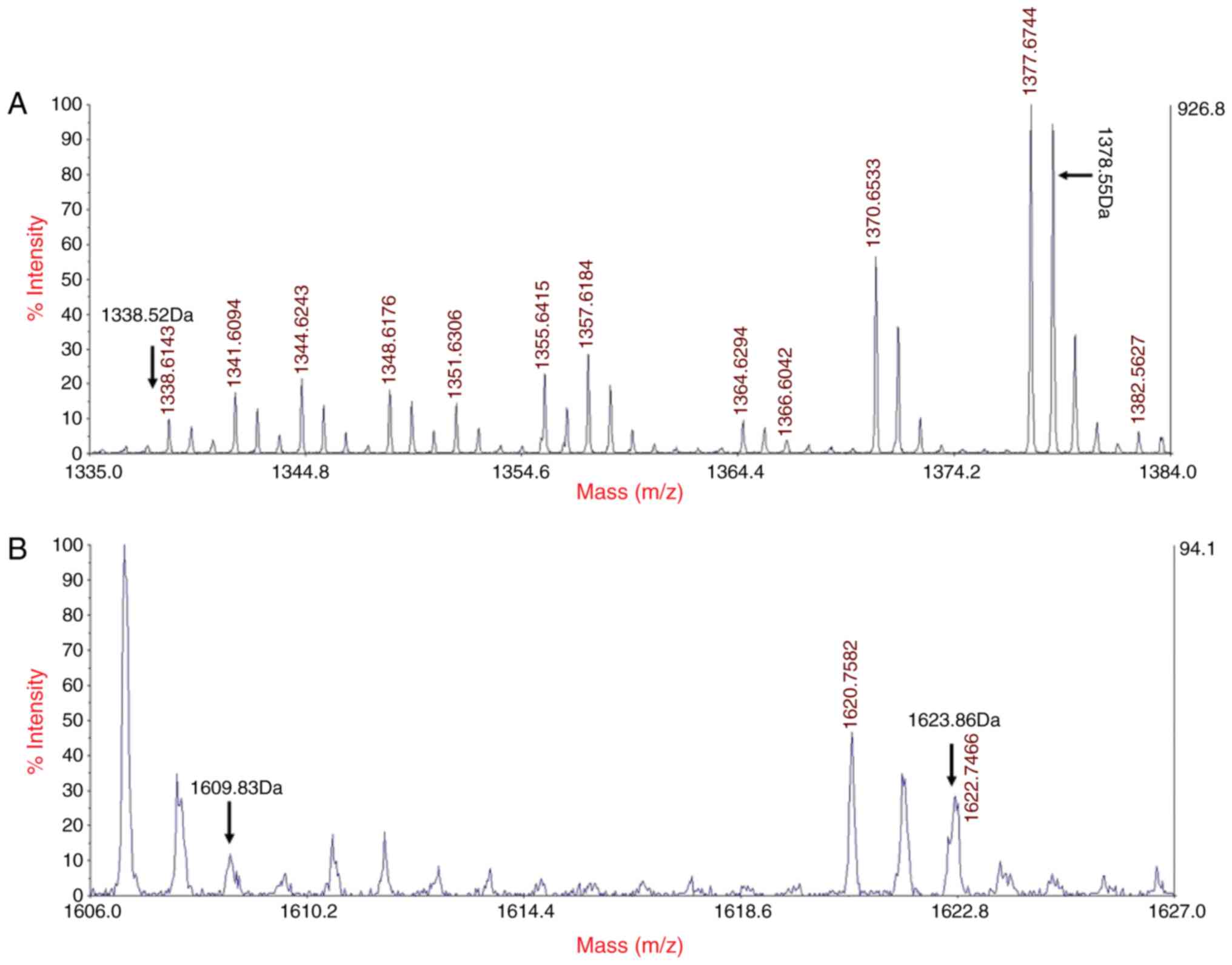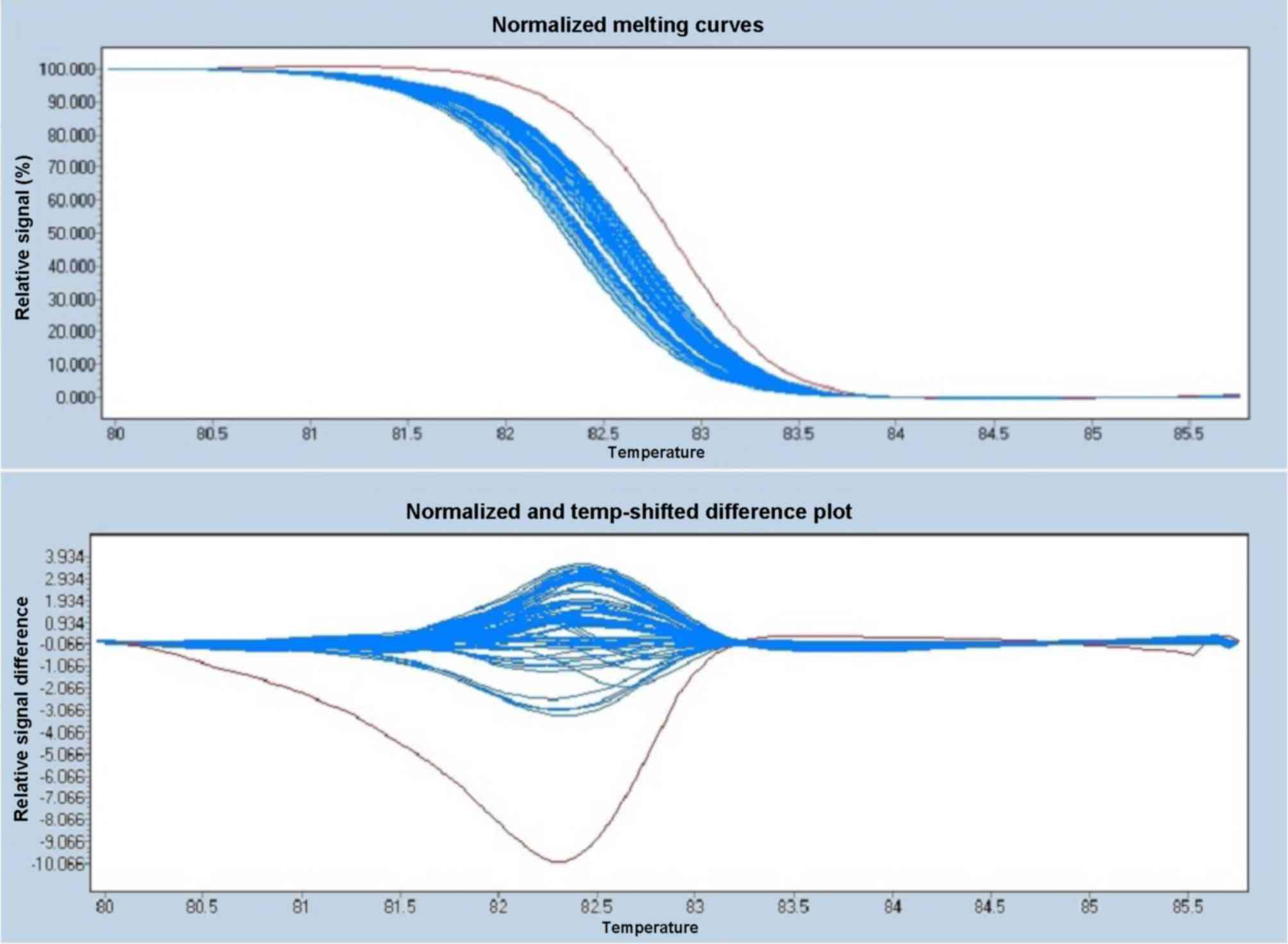Novel compound heterozygous SPTA1 mutations in a patient with hereditary elliptocytosis
- Authors:
- Published online on: February 26, 2018 https://doi.org/10.3892/mmr.2018.8632
- Pages: 5903-5911
-
Copyright: © Ma et al. This is an open access article distributed under the terms of Creative Commons Attribution License.
Abstract
Introduction
Hereditary elliptocytosis (HE) disease refers to a type of familial inherited hemolytic disease that is characterized by a broad spectrum of clinical severities, ranging from an asymptomatic carrier to life-threatening anemia with transfusion-dependency (1). The main inheritance mode of HE is autosomal dominant; the other modes are associated with true recessive inheritance and novel mutations. The global incidence of HE disease is high, particularly in the malaria-endemic areas of West Africa where the prevalence of HE is 2% (2). The typical clinical characteristics of HE include, splenomegaly, jaundice and anemia, with the presence of elliptically shaped erythrocytes in peripheral blood smears. However, due to high levels of heterogeneity, patients with HE can easily be misdiagnosed and there are ~1/3,000 heterozygous mutation carriers in the world with no obvious signs of jaundice or anemia (3). A common molecular biological basis of all types of HE is either a deficiency or dysfunction of one or more of the following 3 proteins: Protein 4.1, and α- and β-spectrin proteins encoded by the genes, erythrocyte membrane protein band 4.1 (EPB41), spectrin α chain erythrocytic 1 (SPTA1) and spectrin β chain erythrocytic (SPTB), respectively (4). In particular, α- and β-spectrin proteins alter the morphology of erythrocytes, from the normal biconcave disc structure toan elliptical shape, there by causing the irreversible deformity of red blood cells (RBCs) (5). Heteromorphic erythrocytes are susceptible to being trapped within the splenic cord and are removed by the splenic reticuloendothelial system, which can lead to hemocytolysis and increased free bilirubin levels.
The SPTA1 gene is 80 k Bin length, contains 52 exons and is located on chromosome 1q22-q23. The gene encodes a 2,429 amino acid-long protein, α-spectrin, which accounts for 21% of total erythrocyte membrane proteins. It constitutes the lateral linkage of the erythrocyte membrane skeleton protein network with β-spectrin and protein 4.1 (6). In the present study, a novel molecular defect in α-spectrin, His54Pro, was detected, which resulted in a heterozygous point substitution in exon II of the SPTA1 gene. In addition, clinical characteristics and laboratory results of the proband and their family are summarized to provide a reference for prenatal check-ups and diagnosis of HE.
Materials and methods
Routine examination
Written informed consent was obtained from all participants enrolled in the present study. The study protocol was approved by the Ethics Committee of The First Affiliated Hospital at the Guangxi Medical University (Nanning, China). A total of 7 ml of blood was collected from the proband and 95 healthy volunteers (2 ml of blood was used for EDTA anticoagulation and 5 ml was used for separation of coagulation factors). The proband (3 year old female) was recruited following routine surgery at the Department of Clinical Laboratory, The First Affiliated Hospital of Guangxi Medical University, and all participants (57 males and 38 females; mean age of 23.15±11.59 years; age range of 7–51 years) in the present study were recruited between January 2016 and December 2016 at The First Affiliated Hospital of Guangxi Medical University.
Blood tests, including RBC count, hemoglobin (HGB) levels, mean corpuscular volume (MCV), mean corpuscular hemoglobin (MCH), mean sphered blood cell volume (MSCV), mean reticulocyte volume, reticulocyte (RET) levels and mean platelet volume (MPV), were performed using the LH 780 automated hematology analyzer (Beckman Coulter, Inc., Brea, CA, USA). For assessment of liver function, levels of total bilirubin (TBiL) and direct bilirubin (DBiL) were determined using the 7600 Fully Automated Biochemical Analyzer (Hitachi, Ltd., Tokyo, Japan).
Preparation of RBC membrane protein extract
A low-osmotic hemolysis method was used to extract the erythrocyte membrane protein content as previously described (7). Briefly, the packed RBCs were separated by centrifugation at 3,000 × g for 5 min at room temperature. Subsequently, 50 µl of packed RBCs and 15 µl of phenylmethylsulfonyl fluoride (Beijing Solarbio Science & Technology Co., Ltd., Beijing, China) were added to 750 µl erythrocyte lysis buffer (Solarbio Science & Technology Co., Ltd.) and incubated for 30 min at 4°C. Totalerythrocyte membrane proteins were then harvested by centrifugation at 12,000 × g for 20 min at 4°C. The precipitate was washed three times with 0.1 mol/l PBS at 4°C. Following the third PBS wash, the precipitate was stored at −20°C until further use.
Separation and evaluation of RBC membrane protein content
RBC membrane proteins were analyzed within 15 days of extraction using 3.5–17% SDS-PAGE according to Fairbanks et al (8). SDS loading buffer, containing β-mercaptoethanol, was added to membrane proteins, and the mixture was incubated at 37°C for 30 min to allow for the reduction of disulfide bonds, followed by a brief centrifugation at 3,000 × g for 10 sec at room temperature. The gel was stained with Coomassie brilliant Blue R-250, and then destained at room temperature overnight in double-distilled water. A Gel Doc 2000 electrophoresis gel imaging system (Bio-Rad Laboratories, Inc., Hercules, CA, USA) was used to scan the gel and Quantity One software (version 4.6; Bio-Rad Laboratories, Inc.) was used to analyze the relative quantitative values of the proteins.
Eosin-5-maleimide (EMA)-labeling of RBCs and flow cytometry
This method was conducted according to King et al (9). EMA reagent (Sigma-Aldrich; Merck KGaA, Darmstadt, Germany) was diluted in 0.01 mol/l PBS to a final concentration of 0.5 mg/ml, stored at −20°C and then thawed at 4°Cprior to usage. Freshly anti coagulated blood was washed three times with PBS and centrifuged at 1,500 × g for 5 min at room temperature following each wash. Subsequently, 25 µl EMA solution and 5 µl washed RBCs were mixed and incubated at room temperature for 1 h in the dark. The precipitate was washed three times with PBS containing 0.5% bovine serum albumin (Invitrogen; Thermo Fisher Scientific, Inc., Waltham, MA, USA) and centrifuged at 1,500 × g for 5 min at room temperature following each wash. The supernatant was discarded and the cells were resuspended in 500 µl PBS for subsequent analysis using a flow cytometer (Beckman Coulter, Inc.). A total of 15,000 cells were acquired using the FL-1 channel and data analysis was conducted using Flow Jo software (version 10.2; Flow Jo LLC, Ashland, OR, USA). The results were expressed as the ratio of the mean channel florescence (MCF) of the study subject to the healthy controls. The formula used was as follows:
Patients%=ControlMCF–PatientsMCFControlMCFx100%Where, Control MCF=(MFC1+MFC2+MFC3+MFC4+MFC5+MFC6+MFC7+MFC8+MFC9+MFC10)/10.
Gene sequence analysis
Genomic DNA from peripheral blood samples was extracted using the Gene JET Whole Blood Genomic DNA Purification Mini kit (Thermo Fisher Scientific, Inc.) according to the manufacturer's instructions. Primers were designed based on exon sequences and adjacent intron sequences of SPTA1, SPTB and EPB41, and were synthesized by BGI Sequencing (Cambridge, MA, USA), and were as follows: Exon 2, forward 5′-ACACATATAAGCGGGGCAAC-3′ and reverse, 5′-TTGTACCCACACATACCCATTAAC-3′; exon 40, forward 5′-TGAGTGAATATAGATTTTCCGGC-3′ and reverse 5′-TTCTACATTTGGGCCAGTCC-3′; and intron 45, forward 5′-TGGACAGATTCATGTTTTGTGG-3′ and reverse 5′-TGGAATGAAAATGTCTCAGCAC-3′. The polymerase chain reaction (PCR) mixture consisted of 25 µl of 2X Taq PCR Master Mix (Takara Biotechnology Co., Ltd.), 2 µl of genomic DNA, 1 µl each of the forward and reverse primers, and ddH2O to a final volume of 50 µl. The reaction conditions were as follows: Pre-denaturation at 95°C for 5 min, followed by 35 cycles of 95°C for 30 sec, annealing (at the optimal annealing temperature per primer set) for 30 sec 72°C for 40 sec. The final extension was at 72°C for 8 min and 4°C for storage. The PCR products were sent to BGI Sequencing for purification, recovery and bi-directional sequencing. The sequencing results were compared with the standard sequences stored in the NCBI database (https://www.ncbi.nlm.nih.gov/gene/). Sequencing results were confirmed by twice repeated PCR amplification and sequencing analysis via comparison with the published sequences of homologous species obtained from the NCBI database (https://www.ncbi.nlm.nih.gov/gene/), which was performed using Chromas 2.6.4 software (Technelysium Pty Ltd., Brisbane, Queensland, Australia).
Matrix-assisted laser desorption-ionization time of flight mass spectrometry (MALDI-TOF MS)
In-gel enzymolysis was performed according to the methods described by Gharahdaghi et al (10) Protein samples of the proband and the healthy controls were separated by SDS-PAGE and stained with Coomassie brilliant blue according to the aforementioned protocol. Distinct target protein bands were removed from the gel and collected. Following de-staining and washing, the proteins were dehydrated for 10 min using pure acetonitrile (ACN) at room temperature and vacuum dried. The proteins then underwent overnight enzymatic digestion in 1U/µl trypsin in 30 µl enzymolysis buffer (40 mM NH4HCO3 and 10% ACN) at room temperature. Proteins were extracted and centrifuged at 10,000 × g at room temperature for 5 min. The top-layer solution was extracted, concentrated and dried in a vacuum dryer, then re-dissolved in 0.1% trifluoroacetic acid. The proteins were analyzed using a 4800 Plus System Mass spectrometer (SCIEX, Framingham, MA, USA).
High resolution melting (HRM)
PCR amplification and HRM curve analysis were conducted using a Light Cycler 480 II Fluorescence Quantitative PCR Instrument (Roche Applied Science, Penzberg, Germany) and the Light Cycler 480 High Resolution Melting Master kit (Roche Applied Science) in accordance with the manufacturer's protocol. The total reaction volume was 20 µl, containing 10 µl of Master Mix, 3.6 µl of Mg2+, 2 µl of DNA template, and 0.5 µl each of the forward and reverse primers. Based on the mutations of the proband and their family members, HRM primers were designed using Premier 5.0 software (Premier Biosoft International, Palo Alto, CA, USA). The primer sequences were as follows: Forward, 5′-GAGGCGTCAGGAAGTGTT-3′ and reverse, 5′-CTGCATCTCGCTTGAAAA-3′. HRM detection and data analysis were conducted using the Light Cycler 480 II instrument. There action conditions were as follows: Enzyme activation at 95°C for 5 min, followed by PCR amplification at 95°C for 10 sec, 49°C for 15 sec 72°C for 25 sec (fluorescence detection) for a total of 40 cycles. Melting was performed at 95°C for 1 min, 40°C for 1 min, 70°C for 1 sec 95°C (fluorescencedetection at 40 times/sec) for 1 min, followed by cool down at 40°C for 10 sec. Following the completion of the reaction, HRM curve analysis was performed using the Light Cycler 480 Gene Scanning software (version 1.5; Roche Applied Science).
Results
Patient and blood routine tests
The proband, a 3 year old female, was hospitalized due to recurrent xanthochromia over a period of 3 years and exhibited brown-colored urine. Immediately following birth, neonatal pathologic jaundice and ABO hemolytic disease of the newborn were observed in this patient. In the local hospital, this patient received exchange transfusion, phototherapy to treat jaundice and additional treatments, and was discharged following signs of improvement. The mother had a history of hepatitis B (Hb) and tested positive for Hb surface antigen, Hb e-antigenand Hb core antibody. Due to an infection, the patient was examined at the local hospital, where test results revealed 33.3×109/l white blood cells (WBCs), 72 g/l HGB and 383 µmol/l TBiL. Following anti-infection and liver protection treatments, the levels of WBC, HGB and TBiL were reduced to 6.99×109/l,93 g/l and 166.7 µmol/l, respectively. The patient was then transferred to The First Affiliated Hospital of Guangxi Medical University on July 15th, 2016.
Physical and auxiliary examinations performed following hospitalization revealed that the patient was conscious with no signs of fever or bleeding under the skin. The proband presented with xanthochromia, scleral icterus in both eyes and slight redness in the pharynx. The liver and spleen were palpable at 2 cmunder the ribs, with a medium hardness, and were slightly obtuse on the edge. Ultrasound examination revealed hepatomegaly and splenomegaly, with multiple masses near the abdominal aorta. No echo abnormalities were observed in gallbladder or spleen. Laboratory tests demonstrated 1+urobilinogen, 0.19 µmol/24 h urine copper, increased activated partial thromboplastin time (53.20 sec), 580.2 mg/l ceruloplasmin, MSCV<MCV and increased osmotic fragility of erythrocytes. Analysis of peripheral erythrocyte morphology revealed anisocytosisthat was dominated by smaller erythrocytes. Elliptocytes, characterized by helmet-shaped and spherical RBCs, were markedly identifiable and accounted for ~16% of the total erythrocyte population (Fig. 1). Glucose-6-phosphate dehydrogenase enzymatic activity was normal, and no abnormalities were detected in hemoglobin electrophoresis analysis and thalassemia-gene analysis. The patient tested negative for the Coombs test; the clinical manifestations and the laboratory test results led to the diagnosis of the patient with HE. Subsequently, routine blood and biochemical tests were conducted on the patient's family members. The results are presented in Table I.
Analysis of the erythrocyte membrane proteins
Erythrocyte membrane proteins of the proband and their family members were analyzed by SDS-PAGE. Coomassie brilliant blue staining was quantified using Quantity One analysis software, and the level of α-spectrin expression was expressed as α-spectrin/b and 3 (Fig. 2). The results of the present study indicated that there were no marked differences in the amount of membrane proteins between the HE patient or their family members when compared with healthy individuals.
DNA analysis
Compared with the standard sequences that are available in the NCBI database, PCR amplification and direct sequencing of the proband's genomic DNA revealed 3 mutations in the SPTA1 gene within the hereditary elliptocytosis family (Fig. 3). The first mutation was a heterozygous mutation c.161A>C in exon 2, which resulted in a His54>Pro54 substitution in α-spectrin. The second mutation was a heterozygous mis sense mutation c.5572C>G in exon 40, which resulted in Leu1858>Val1858. The third mutation was a heterozygous mutation 6531-12C>T in intron 45. Mutation analysis of the proband's family members confirmed that their father and paternal grandmother were carriers of the c.161A>C mutation, and their mother was a carrier of both the c.5572C>G and 6531-12 C>Tmutations (Fig. 4).
MALDI-TOF MS analysis
MALDI-TOF MS analysis of the proband's α-spectrin peptide chain indicated that the digested fragments of the mutant peptides were LEDSYPLQVFK and GDCGDTLAATQSLVMK rather than LEDSYHLQVFK and GDCGDTLAATQSLLMK, which are present in the normal peptide. These mutations were heterozygous and identifiable by 2 molecular ion peaksat 1,378.55–1,338.52 and 1,623.86–1,609.83 kDa, respectively; these corresponded to the mass numbers of the normal peptide and the mutant peptide of the 2 mutations detected in the proband (Fig. 5).
Typical fluorescence profiles for EMA-labeled RBCs
In order to reduce the level of error, blood samples collected from 10 healthy individuals (5 males and 5 females; mean age of 7±2.09 years; age range of 5–12 years) were used as negative controls for EMA-labeled RBC analysis (11) The results of the present study indicated that, when compared with the healthy controls, the fluorescence peaks of the proband, and their father and grandmother were shifted to the left, and the MCF readings were reduced by 30.81, 12.50 and 17.53%, respectively. In addition, no significant differences were observed in the fluorescence peaks between the proband's mother and healthy controls (Fig. 6).
Polymorphism analysis
HRM analysis of the proband (known genotype) and 95 controls (unknown genotype) demonstrated that the proband had an A/C genotype, while all 95 healthy controls hadan A/A genotype. The allele frequency in the proband was 1.0% and the melting curves are presented in Fig. 7.
Discussion
HE is a type of extra vascular hemolytic anemia, characterized by an increased number of elliptocytes in the peripheral blood (12). HE has been reported globally, and its incidence rate greatly varies among a variety of ethnicities and geographical regions (13) The primary difference between hereditary spherocytosis (HS) and HE, is that HE is caused by mutations in the genes encoding transverse linkages of cytoskeleton proteins in the erythrocyte membrane, resulting in functional changes of the cell membrane and decreased morphotropism. The most common causes of HE are structural defects in contractile proteins, which have been reported in 65% of patients with HE (14). As the number of α-and β-spectrin dimmers that form into tetramers decreases, certain segments of the normal peptide chain are replaced by abnormal peptides, resulting in abnormal RBC function, reduced erythrocyte membrane surface area and increased membrane osmotic fragility (15) These abnormal RBCs are detained and broken into RBC debris in the spleen, leading to hemolytic anemia. Notably, a significant portion of RBC debris can be misclassified by blood cell analyzers as platelets, resulting in a false increase in the level of platelets (16). In this case, it is recommended to perform manual counting.
As HE can result from various genetic defects, clinical symptoms can vary greatly among patients, ranging from asymptomatic to chronic hemolytic anemia to a plastic crisis. Therefore, based on the patient's RBC count, hemoglobin, RET, level of jaundice and splenomegaly, and other indicators, HE may be categorized as asymptomatic, compensated hemolytic anemiaor hemolytic anemia. Asymptomatic and compensated hemolytic anemic patients exhibit no apparent clinical symptoms, including anemia, jaundice and splenomegaly; therefore, without genetic testing, HE may remain unidentified. Generally, patients with a single heterozygous mutation are often considered asymptomatic, such as the absence of anemia and hemolytic tendency in the proband's father and grandmother. Homozygous mutations or compound heterozygous mutations may account for ~10% of cases, and patients often exhibit moderate to severe hemolysis and require a blood transfusion (17).
In the present study, 3 heterozygous mutations were identified within the proband; laboratory tests indicated that the proband exhibited symptoms of anemia, jaundice and splenomegaly, and an increased level of RET. Only families carrying mutations in the SPTA1 gene may be asymptomatic and symptomatic, while families carrying mutations in the SPTB gene or EPB41 gene may not exhibit such diverse clinical manifestations. For the proband, the defect in the self-assembly of spectrin was one of the major causes of abnormal morphology of RBCs (18). DNA analysis of the probandrevealed no mutations within the SPTB and EPB41 geneshowever, 3 mutations were identified in the SPTA1 gene. In particular, the heterozygous mutationc. 161A>C in exon 2 resulted in a histidine to proline substitution at amino acid 54, a novel mutation site; its role in disease pathogenesis has not yet been identified, however, this mutation may affect the mRNA expression levels or structural stability of proteins, or block the self-assembly of spectrin dimers to tetramers, resulting in abnormal transverse linkage with actin proteins. In addition, DNA mutation analysis of the proband's family members revealed that the patient's father and grandmother carried the c.161A>C point mutation. HRM-based genotyping demonstrated that the A/A form was predominant among healthy controls. At present, The Single Nucleotide Polymorphism database of the 1,000 Genomes Project (www.ncbi.nlm.nih.gov/projects/SNP/), does not have a record of mutations at this site; thus, the frequency among the general population is unknown. Therefore, based on the associations between clinical phenotype and genotype inheritance, this locus may be associated with the manifestation of HE in the proband.
The c.5572C>G mutation in exon 40 and the 6531-12C>T mutation in intron 45 constituted the polymorphic, high frequency and low expression αLELY locus. The former caused an amino acid substitution, while the latter led to a 50% reduction in mRNA transcription levels of exon 46 of α-spectrin, inhibiting the ability to form stable dimmers (19). Individuals with the αLELY polymorphism, whether heterozygous or homozygous, do not exhibit any clinical symptoms as αLELY in cis maintains an over expression of the α-spectrin protein. However, when αLELY is present with other mutations in SPTA1, these mutations will increase the concentration of α-spectrin αLELY in transon the erythrocyte membrane, and consequently reduce the concentration of αLELY in cis (20). As a result, the carrier will exhibit more severe clinical symptoms (21). In the proband's family, their paternal line carried the c.161A>C mutation and their maternal line carried the αLELY polymorphism. As these mutations have no effect on α-spectrin protein expression levels when they occur independently, no apparent clinical symptoms were observed in individuals of the parental lines. However, when the proband inherited the two mutations, the αLELY polymorphism exacerbated the pathogenic role of c.161A>C in trans, resulting in more significant hemolysis in the proband. Iolascon et al (22) reported a patient with elliptopoikilocytosis who demonstrated a common polymorphic SPTA1 αLELY allele in trans to the SPTA1 αExeter allele. The SPTA1 αExeter allele was inherited from the patient's father and the αLELY allele was inherited from their healthy, asymptomatic mother. Polymorphism αLELY, when in trans to Exeter mutations, aggravated the symptoms in proportion to the intrinsic severity of the αExeter intrinsic severity.
MALDI-TOF MS is a novel type of soft-ionization MS that has fast, accurate, sensitive and high-throughput properties (23). In the present study, MALDI-TOF MS was employed, which demonstrated that the proband possessed the mutant peptides, including 1,338.52 kDa (LEDSYPLQVFK) and 1,609.83 kDa (GDCGDTLAATQSLVMK), as well as the normal peptides 1,378.55 kDa (LEDSYHLQVFK) and 1,623.86 kDa (GDCGDTLAATQSLLMK), indicating the presence of heterozygous mutations.
Laboratory tests are important for assisting the diagnosis of HE. While the diagnosis of HE mainly relies on the presence of >25% elliptocytes in the peripheral blood smear (24), the elliptocyte count of the proband in the present study was <25%. Therefore, further investigation into clinical manifestations and accompanying laboratory tests is required (25). The proband exhibited a typical clinical manifestation; however, information regarding family history was unavailable. During the early period of hospitalization, the proband demonstrated no improvement in jaundice symptoms following treatment with reducing glutathione tablets, and was thereby re-admitted to the hospital. Blood cell parameters of the proband were evaluated and increased MCV levels were observed when compared with their MSCV levels. In addition, erythrocyte morphological examination indicated the presence of elliptocytes. Considering the patient's history, clinical manifestations and laboratory test results, the patient was diagnosed with HE. Consistent with the genetic analysis of their family members, laboratory test results revealed that the patient's father and grandmother had MCV>MSCV levels, indicating that MCV>MSCV has a diagnostic value in HS patients (26) and also a diagnostic potency for HE patients.
In the present study, a defect in the proband's membrane proteins was not detected by SDS-PAGE analysis. Excessive RET affected the gradient concentration of the separation gel and the separation of membrane proteins (27); however, the EMA-binding test revealed abnormalities in the RBCs of the proband. The EMA-binding test is primarily used to label band 3 proteins on the erythrocyte membrane and is recommended as a screening method for the diagnosis of HS (28). It has been suggested that the band 3protein had the same diagnostic potency in other RBC membrane diseases (9,17). The results of the present study revealed that the proband had reduced levels of EMA-labeled erythrocytes compared with healthy controls, suggesting that the EMA-binding test may be promising for the screening of HE.
HRM analysis is an emerging molecular diagnostic technique based on the monitoring of changes in the melting curves of nucleic acids, indicated by the saturation of fluorescence by quantitative PCR. HRM analysis is not limited by nucleotide positions and types, and does not require sequence-specific probes (29). In addition, HRM analysis identifies mutations by analyzing changes in the melting curves of PCR products. The formation of a heterologous double-stranded DNA (dsDNA) in a heterozygous mutation that results in a melting curve that is significantly different compared with that of homozygous dsDNA. In the present study, HRM was used for gene mutation screening as it has many advantages, including high sensitivity and specificity, low cost and high-throughput. HRM analysis was employed to screen the His54Pro mutation in the SPTA1 gene of the proband and 95 healthy controls, which revealed that the His54Pro mutation rate was 1.0%. This indicated that the His54Pro mutation was a rare mutation site with a low incidence rate among the healthy population.
Special treatment is generally not required when a patient with HE exhibits no or only mild signs of anemia (30). During the early stages, infection in the proband aggravated their anemia and jaundice, and their HGB levels (72 g/l) fell to a level that required blood transfusion. Following control of the infection, the proband's HGB levelsreturned to 93 g/l and their bilirubin levelsmarkedly reduced. This suggestedthat an infection in a HE patient requires timely anti-infection treatment and close monitoring rather than an immediate blood transfusion as the HGB count can eventually recover independently. Unnecessary transfusion of blood products can induce systemic allergic reactions and also increase the risk of infectious diseases (31). Furthermore, the transfused RBCs may be abnormally damaged in the recipient's body due to immune or non-immune responses, which may result in further hemolysis.
In conclusion, a novel SPTA1 gene mutation was detected in a HE proband and the corresponding mutant peptide segments was confirmed by MALDI-TOF MS. The HE-associated clinical manifestations are quite diverse; therefore, HE may be misdiagnosed or undetected. In the present study, comprehensive analysis using EMA-labeled flow cytometry and SDS-PAGE was performed to detect protein defects; blood smear morphologic examinations and routine laboratory tests for Hb, MCV, MSCV, RET%, TBIL and DBIL may improve the rate of diagnosis and timely treatment of HE, as well as reducing the risk of HE-associated complications.
Acknowledgements
The present study was supported by the National Natural Science Foundation of China (grant no. 81360263).
Competing interests
The authors declare that they have no competing interests.
Glossary
Abbreviations
Abbreviations:
|
HE |
hereditary elliptocytosis |
|
MSCV |
mean sphered corpuscular volume |
|
EMA |
eosin-5-maleimide |
|
MALDI-TOF |
matrix-assisted laser desorption-ionization time of flight |
|
MCF |
mean channel florescence |
|
HRM |
high resolution melting |
References
|
An X and Mohandas N: Disorders of red cell membrane. Br J Haematol. 141:367–375. 2008.PubMed/NCBI | |
|
Gallagher PG: Hereditary elliptocytosis: Spectrin and protein 4.1R. Semin Hematol. 41:142–164. 2004. View Article : Google Scholar : PubMed/NCBI | |
|
Christensen RD, Nussenzveig RH, Reading NS, Agarwal AM, Prchal JT and Yaish HM: Variations in both alpha-spectrin (SPTA1) and beta-spectrin (SPTB) in a neonate with prolonged jaundice in a family where nine individuals had hereditary elliptocytosis. Neonatology. 105:1–4. 2014. View Article : Google Scholar : PubMed/NCBI | |
|
Gaetani M, Mootien S, Harper S, Gallagher PG and Speicher DW: Structural and functional effects of hereditary hemolytic anemia-associated point mutations in the alpha spectrin tetramer site. Blood. 111:5712–5720. 2008. View Article : Google Scholar : PubMed/NCBI | |
|
Iolascon A, Miraglia del Giudice E and Camaschella C: Molecular pathology of inherited erythrocyte membrane disorders: Hereditary spherocytosis and elliptocytosis. Haematologica. 77:60–72. 1992.PubMed/NCBI | |
|
Delaunay J, Alloisio N, Morle L, Baklouti F, Dalla Venezia N, Maillet P and Wilmotte R: Molecular genetics of hereditary elliptocytosis and hereditary spherocytosis. Ann Genet. 39:209–221. 1996.PubMed/NCBI | |
|
Rungaldier S, Oberwagner W, Salzer U, Csaszar E and Prohaska R: Stomatin interacts with GLUT1/SLC2A1, band 3/SLC4A1, and aquaporin-1 in human erythrocyte membrane domains. Biochim Biophys Acta. 1828:956–966. 2013. View Article : Google Scholar : PubMed/NCBI | |
|
Fairbanks G, Steck TL and Wallach DF: Electrophoretic analysis of the major polypeptides of the human erythrocyte membrane. Biochemistry. 10:2606–2617. 1971. View Article : Google Scholar : PubMed/NCBI | |
|
King MJ, Jepson MA, Guest A and Mushens R: Detection of hereditary pyropoikilocytosis by the eosin-5-maleimide (EMA)-binding test is attributable to a marked reduction in EMA-reactive transmembrane proteins. Int J Lab Hematol. 33:205–211. 2011. View Article : Google Scholar : PubMed/NCBI | |
|
Gharahdaghi F, Weinberg CR, Meagher DA, Imai BS and Mische SM: Mass spectrometric identification of proteins from silver-stained polyacrylamide gel: A method for the removal of silver ions to enhance sensitivity. Electrophoresis. 20:601–605. 1999. View Article : Google Scholar : PubMed/NCBI | |
|
Hunt L, Greenwood D, Heimpel H, Noel N, Whiteway A and King MJ: Toward the harmonization of result presentation for the eosin-5′-maleimide binding test in the diagnosis of hereditary spherocytosis. Cytometry B Clin Cytom. 88:50–57. 2015. View Article : Google Scholar : PubMed/NCBI | |
|
Soderquist C and Bagg A: Hereditary elliptocytosis. Blood. 121:30662013. View Article : Google Scholar : PubMed/NCBI | |
|
Nakanishi H, Wada H, Suemori S and Sugihara T: Hereditary red cell membrane disorders in Japan: Comparison with other countries. Rinsho Ketsueki. 56:760–770. 2015.(In Japanese). PubMed/NCBI | |
|
An X: The red cell membrane, part 2: Disorders of the red cell membrane. Clin Adv Hematol Oncol. 12:606–608. 2014.PubMed/NCBI | |
|
Alloisio N, Morlé L, Maréchal J, Roux AF, Ducluzeau MT, Guetarni D, Pothier B, Baklouti F, Ghanem A, Kastally R and Delaunay J: Sp alpha V/41: A common spectrin polymorphism at the alpha IV-alpha V domain junction. Relevance to the expression level of hereditary elliptocytosis due to alpha-spectrin variants located in trans. J Clin Invest. 87:2169–2177. 1991. View Article : Google Scholar : PubMed/NCBI | |
|
Mullier F, Lainey E, Fenneteau O, Da Costa L, Schillinger F, Bailly N, Cornet Y, Chatelain C, Dogne JM and Chatelain B: Additional erythrocytic and reticulocytic parameters helpful for diagnosis of hereditary spherocytosis: Results of a multicentre study. Ann Hematol. 90:759–768. 2011. View Article : Google Scholar : PubMed/NCBI | |
|
Suemori S, Wada H, Nakanishi H, Tsujioka T, Sugihara T and Tohyama K: Analysis of hereditary elliptocytosis with decreased binding of Eosin-5-maleimide to red blood cells. Biomed Res Int. 2015:4518612015. View Article : Google Scholar : PubMed/NCBI | |
|
Gallagher PG and Forget BG: Hematologically important mutations: Spectrin variants in hereditary elliptocytosis and hereditary pyropoikilocytosis. Blood Cells Mol Dis. 22:254–258. 1996. View Article : Google Scholar : PubMed/NCBI | |
|
Wilmotte R, Maréchal J, Morlé L, Baklouti F, Philippe N, Kastally R, Kotula L, Delaunay J and Alloisio N: Low expression allele alpha LELY of red cell spectrin is associated with mutations in exon 40 (alpha V/41 polymorphism) and intron 45 and with partial skipping of exon 46. J Clin Invest. 91:2091–2096. 1993. View Article : Google Scholar : PubMed/NCBI | |
|
Delaunay J, Nouyrigat V, Proust A, Schischmanoff PO, Cynober T, Yvart J, Gaillard C, Danos O and Tchernia G: Different impacts of alleles alphaLEPRA and alphaLELY as assessed versus a novel, virtually null allele of the SPTA1 gene in trans. Br J Haematol. 127:118–122. 2004. View Article : Google Scholar : PubMed/NCBI | |
|
Tolpinrud W, Maksimova YD, Forget BG and Gallagher PG: Nonsense mutations of the alpha-spectrin gene in hereditary pyropoikilocytosis. Haematologica. 93:1752–1754. 2008. View Article : Google Scholar : PubMed/NCBI | |
|
Iolascon A, King MJ, Robertson S, Avvisati RA, Vitiello F, Asci R, Scoppettuolo MN and Delaunay J: A genomic deletion causes truncation of alpha-spectrin and ellipto-poikilocytosis. Blood Cells Mol Dis. 46:195–200. 2011. View Article : Google Scholar : PubMed/NCBI | |
|
Zhao G, Xu B, Li X, Tang C, Qin H, Wang H, Yang S, Wang W, Gao H, He K and Liu X: Detection of serum peptides in patients with lung squamous cell carcinoma by MALDI-TOF-MS and analysis of their correlation with chemotherapy efficacy. Zhongguo Fei Ai Za Zhi. 20:318–325. 2017.PubMed/NCBI | |
|
Gallagher PG: Red cell membrane disorders. Hematology Am Soc Hematol Educ Program. 2005:13–18. 2005. | |
|
Nie N, Shao YQ, Shi J, Ge M and Zhen Y: Clinical analysis of five patients with hereditary elliptocytosis. Clin J Hematol. 6:540–541. 2013.(In Chinese). | |
|
Liao L, Deng ZF, Qiu YL, Chen P, Chen WQ and Lin FQ: Values of mean cell volume and mean sphered cell volume can differentiate hereditary spherocytosis and thalassemia. Hematology. 19:393–396. 2014. View Article : Google Scholar : PubMed/NCBI | |
|
King MJ and Zanella A: Hereditary red cell membrane disorders and laboratory diagnostic testing. Int J Lab Hematol. 35:237–243. 2013. View Article : Google Scholar : PubMed/NCBI | |
|
King MJ, Garçon L, Hoyer JD, Iolascon A, Picard V, Stewart G, Bianchi P, Lee SH and Zanella A: ICSH guidelines for the laboratory diagnosis of nonimmune hereditary red cell membrane disorders. Int J Lab Hematol. 37:304–325. 2015. View Article : Google Scholar : PubMed/NCBI | |
|
Druml B and Cichna-Markl M: High resolution melting (HRM) analysis of DNA-its role and potential in food analysis. Food Chem. 158:245–254. 2014. View Article : Google Scholar : PubMed/NCBI | |
|
Barcellini W, Bianchi P, Fermo E, Imperiali FG, Marcello AP, Vercellati C, Zaninoni A and Zanella A: Hereditary red cell membrane defects: Diagnostic and clinical aspects. Blood Trasfus. 9:274–277. 2011. | |
|
Yan J, Deng D, Luo M, Cheng P, Chi B, Yuan Y, Liao L and Lin F: Dysfibrinogenemia in a patient undergoing artificial abortion after misdiagnosis and review of the literature. Clin Chim Acta. 447:86–89. 2015. View Article : Google Scholar : PubMed/NCBI |



